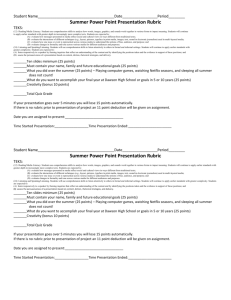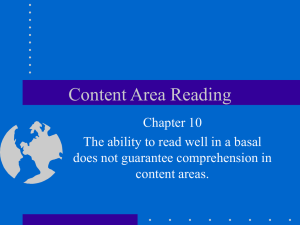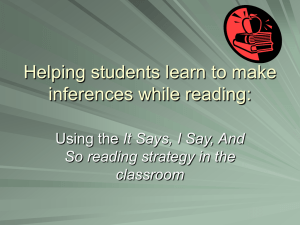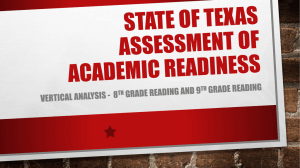TEKS
advertisement
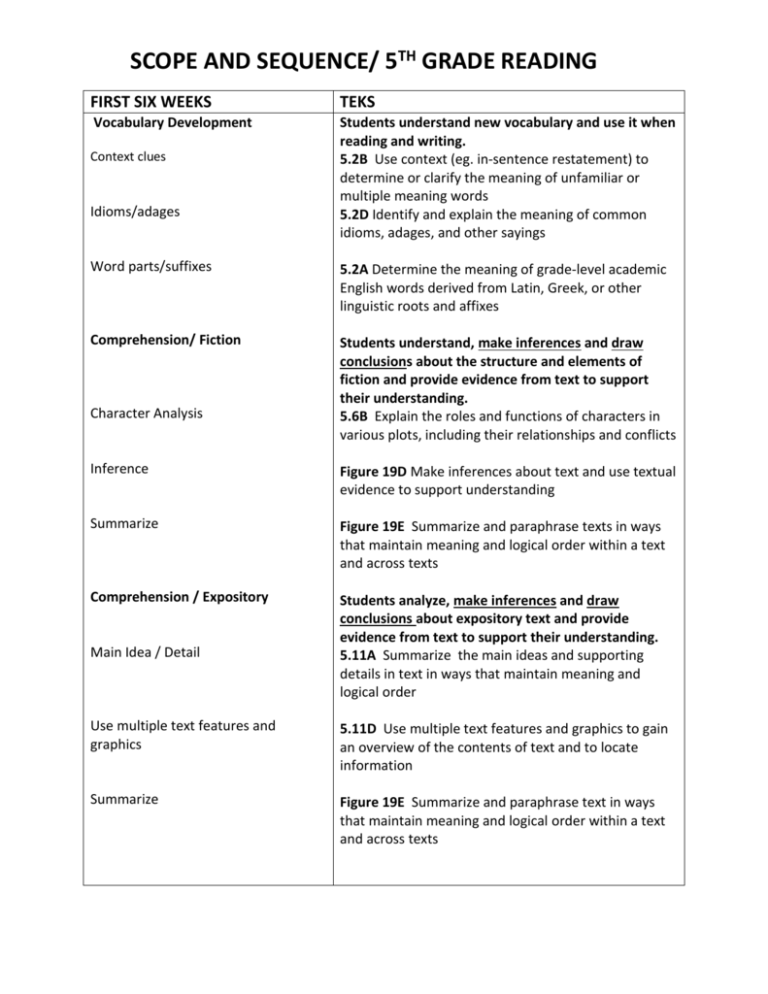
SCOPE AND SEQUENCE/ 5TH GRADE READING FIRST SIX WEEKS TEKS Vocabulary Development Students understand new vocabulary and use it when reading and writing. 5.2B Use context (eg. in-sentence restatement) to determine or clarify the meaning of unfamiliar or multiple meaning words 5.2D Identify and explain the meaning of common idioms, adages, and other sayings Context clues Idioms/adages Word parts/suffixes 5.2A Determine the meaning of grade-level academic English words derived from Latin, Greek, or other linguistic roots and affixes Comprehension/ Fiction Students understand, make inferences and draw conclusions about the structure and elements of fiction and provide evidence from text to support their understanding. 5.6B Explain the roles and functions of characters in various plots, including their relationships and conflicts Character Analysis Inference Figure 19D Make inferences about text and use textual evidence to support understanding Summarize Figure 19E Summarize and paraphrase texts in ways that maintain meaning and logical order within a text and across texts Comprehension / Expository Students analyze, make inferences and draw conclusions about expository text and provide evidence from text to support their understanding. 5.11A Summarize the main ideas and supporting details in text in ways that maintain meaning and logical order Main Idea / Detail Use multiple text features and graphics 5.11D Use multiple text features and graphics to gain an overview of the contents of text and to locate information Summarize Figure 19E Summarize and paraphrase text in ways that maintain meaning and logical order within a text and across texts SCOPE AND SEQUENCE/ 5TH GRADE READING SECOND SIX WEEKS TEKS Vocabulary Development Students understand new vocabulary and use it when reading and writing. 5.2A Determine the meaning of grade-level academic English words derived from Latin, Greek, and other linguistic roots or affixes Word parts/ Prefixes and suffixes Context Clues 5.2B Use context (eg., in-sentence restatement) to determine or calrify the meaning of unfamiliar or multiple meaning words Use of dictionary, glossary, thesaurus to determine meaning, pronunciation, syllabication, parts of speech, and word choice 5.2E Use a dictionary, a glossary, or a thesaurus to determine the meanings , syllabication, pronunciations, alternate word choices, and parts of speech of words. Analogies with synonyms and antonyms 5.2C Produce analogies with know antonyms and synonyms Comprehension/Culture and History Students analyze, make inferences and draw conclusions about the author’s purpose in cultural, historical, and contemporary contexts and provide evidence from the text to support their understanding. Draw conclusions/author’s purpose 5.10A Draw conclusions from the information presented by an author and evaluate how well the author’s purpose was achieved Comprehensions / Theme and Genre Students analyze, make inferences and draw conclusions about theme and genre in different cultural, historical, and contemporary contexts and provide evidence from the text to support their understanding. Compare and contrast the themes or moral lessons of several works of fiction from various cultures 5.3A Compare and contrast the themes or moral lessons of several works of fiction from various cultures Describe the phenomena explained in myth origins from various cultues 5.3B Describe the phenomena explained in origin myths from various cultures Effect of historical even or movement on theme 5.3C Explain the effect of a historical event or movement on the theme of a work of literature SCOPE AND SEQUENCE/ 5TH GRADE READING THIRD SIX WEEKS TEKS Vocabulary Development Students understand new vocabulary and use it when reading and writing. 5.2A Determine the meaning of grade level academic English words derived from Latin, Greek, and other linguistic roots and affixes Review vocabulary TEKS Comprehension/Fiction Explain how the incident gives rise to future events Explain roles and function of characters in plots 5.2E Use a dictionary , glossary, or a thesaurus to determine the meanings, syllabication, pronunciations, alternate word choice, and parts of speech of words. Students understand, make inferences and draw conclusions about the structure and elements of fiction and provide evidence from text to support their understanding. 5.6A Describe incidents that advance the story or novel, explaining how each incident gives rise to or foreshadows future events 5.6B Explain the roles and functions of characters in various plots, including their relationships and conflicts Explain different forms of third person 5.6C Explain the different forms of third-person points point of view in stories of view in stories Comprehension/ Expository Students analyze, make inferences and draw conclusions about expository text and provide evidence from text to support their understanding. Determine facts and verify 5.11B Determine the facts in text and verify them through established methods Analyze and organize patterns of text and how it influences relationships among ideas 5.11C Analyze how the organizational pattern of a text (eg., cause and effect, compare and contrast, sequential order, logical order, classification schemes) influences the relationships among ideas Synthesize and make connections from text of similar/different genres 5.11E Synthesize and make logical connectons between ideas within a text and across two or three texts representing similar or different genres Use multiple text features and graphics 11.D Use multiple text features and graphics to gain an overview of the contents of text and to locate information Figure 19D Make connections (eg. thematic links, author analysis) between and across multiple texts Make connections between and across various texts SCOPE AND SEQUENCE/ 5TH GRADE READING FOURTH SIX WEEKS TEKS Vocabulary Development Students understand new vocabulary and use it when reading and writing. Review Vocabulary TEKS 5.2A Determine the meaning of grade level academic English words derived from Latin, Greek, and other linguistic roots and affixes 5.2B Context (eg., in sentence restatement) to determine or clarify the meaning of a unfamiliar or multiple meaning words 5.2C Produce analogies with know antonyms and synonyms 5.2D Identify and explain the meaning of common idioms, adages, and other sayings Comprehension/Poetry Students understand, make inferences and draw conclusions about the structure and elements of poetry and provide evidence from text to support their understanding. Analyze how poets use sound effects to reinforce meaning in poems 5.4A Analyze how poets use sound effects (eg., alliteration, internal rhyme, onomatopoeia, rhyme scheme) to reinforce meaning in poems. Comprehension/ Sensory Students understand, make inferences and draw conclusions about how an author’s sensory language creates imagery in literary text and provide evidence from text to support their understanding. Evaluate the impact of sensory details imagery and figurative language 5.8A Evaluate the impact of sensory details, imagery, and figurative language in literary text Comprehension/ Persuasive Students analyze, make inferences and draw conclusions about persuasive text and provide evidence from text to support their analysis. Author viewpoint and explain basic relationship among ideas in argument 5.12A Identify the author’s viewpoint or position and explain the basic relationships among ideas (eg., parallelism, comparison, casuality) in the argument Recognize exaggerated, contradictory, 5.12B Recognize exaggerated, contradictory, or or misleading statements in text misleading statements in text SCOPE AND SEQUENCE/ 5TH GRADE READING FIFTH SIX WEEKS TEKS Comprehension /Theme and Genre Student’s analyze , make inferences and draw conclusions about theme and genre in different cultural, historical, and comtemporary contexts and provide evidence from the text to support their understanding. Describe the phenomena explained in origin myths from various cultures 5.3B Describe the phenomena explained in origin myths from various cultures Comprehension / Drama Students understand, make inferences and draw conclusions about the structure and elements of drams and provide evidence from text to support their understanding. Analyze similarities and differences between an original text and its dramatic adaptation 5.5A Analyze the similarities an differences between an original text and it dramatic adaptation Comprehension / Nonfiction Students understand, make inferences and draw conclusions about the varied structural patterns and features of literary nonfiction and respond by providing evidence from text to support their understanding. Biography /autobiography – identify literary language and devices used including author’s present major events in their life 5.7A Identify the literary language and devices used in biographies and autobiographies, including how authors present major events in a person’s life Comprehension/ Procedural Students understand how to glean and use information in procedural texts and documents. Interpret details from procedural text to complete a task, solve a problem, or perform procedures 5.13A Interpret details from procedural text to complete a task, solve a problem, or perform procedures Reading/ Media Literacy Students use comprehension skills to analyze how words, images, graphics, and sound work in various forms to impact meaning. Identify point of view in media 5.14C Identify point of view in media presentations SCOPE AND SEQUENCE/ 5TH GRADE READING SIX SIXTH WEEKS TEKS Comprehension/ Procedural Students understand how to glean and use information in procedural texts and documents. Interpret factual or quantitative information presented in maps, charts, illustrations, graphs, timelines, tables, and diagrams 5.13B Interpret factual or quantitative information presented in maps, charts, illustrations, graphs, timelines, tables, and diagrams Reading /Media Literacy Students use comprehension skills to analyze how words, images, graphics, and sounds work together in various forms to impact meaning. Explain how messages conveyed in various forms of media are presented differently 5.14A Explain how messages conveyed in various forms of media are presented differently (eg., documentaries, online information, televised news) Consider the difference in techniques used in media 5.14B Consider the difference in techniques used in media (eg., commercials , documentaries, news) Analyze digital media venues 5.14D Analyze various digital media venues for levels of formality and informality


